Thermal expansion
1. Characterize the thermal expansion of solids, liquids, and gases!
Solution:
Thermal expansion is a change in an object's dimensions caused by a change in its temperature.
A.) Solids
1.) Linear expansion:
= coefficient of thermal linear expansion
-
α(Cu)=1.7×10−5K−1
-
α(Al)=2.4×10−5K−1
-
α(Fe)=1.2×10−5K−1
Relative elongation:
2.) Volumetric expansion:
B.) Liquids
Volumetric expansion:
= coefficient of thermal volumetric expansion
-
β(H2O)=1.8×10−4K−1
-
β(diesel)=1.1×10−3K−1
C.) Gases
1.) Volumetric expansion:
= coefficient of expansion is the same for all gases:
2.A copper wire (α = 1,7.10-5K-1) had a length of 21,55 m at a temperature of -50C. What is its length at 300C? By how many cm did the wire lengthen?
Solution:
Analysis:
l0 = 21,55 m, α = 1,7.10-5K-1 = 0,000017 K-1, Δt = 300C - (-50C) = 350C
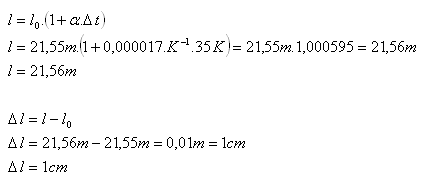
After heating, the wire has a length of 21,56 m. It lengthened by 1 cm.
3.A copper wire (α = 1,7.10-5K-1) whose length at 180C was 150 cm was heated by electric current and elongated by 9 mm. To what temperature was the wire heated?
Solution:
Analysis:
l0 = 150 cm = 1,5 m, t1 = 180C, Δl = 0,009 m, α = 1,7.10-5K-1
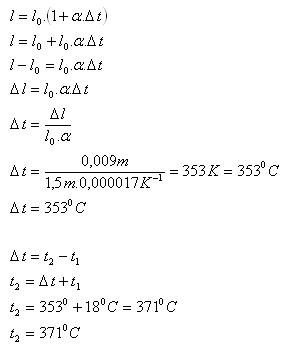
The wire was heated to a temperature of 3710C.
4.Two rods, one iron (α1 = 1,2.10-5K-1) and one zinc (α2 = 2,9.10-5K-1), had the same length at 00C. When their temperature is raised to 1000C, the difference in their lengths is 1 cm. What were their original lengths?
Solution:
Analysis:
α1 = 1,2.10-5K-1, α2 = 2,9.10-5K-1, Δt = 100 K, Δl = 0,01 m

The original lengths of the rods were l0 = 5,88 m.
5.An aluminum container (α (Al) = 24.10-6K-1) has an internal volume of 10 liters at 200C. How does its internal volume change at 1000C?
Solution:
Analysis:
α (Al) = 24.10-6K-1, t1 = 200C, t2 = 1000C, Δt = 800C = 80 K,
V0 = 10 l = 10 dm3 = 10-2 m3
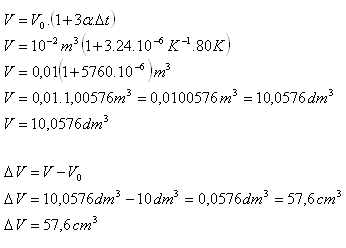
The internal volume of the container increases by 57,6 cm3.
6.Tables state that copper has a density of ρ20 = 8930 kg.m-3 at 200C. What is the density of copper at 800C?
Solution:
Analysis:
ρ20 = 8930 kg.m-3, t1 = 200C, t2 = 800C, Δt = 600C = 60 K, α(Cu) = 1,7.10-5K-1
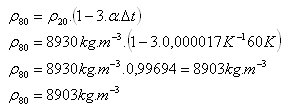
The density of copper at 800C is ρ80 = 8903 kg.m-3.
7.A floor tile is made of marble (α = 0,85.10-5K-1) and is square. The side of the tile has a length of 0,5 m at 00C. By how many cm2 does the area of the tile increase if its temperature is raised to 350C?
Solution:
Analysis:
α = 0,85.10-5K-1, a0 = 0,5 m, Δt = 350C, ΔS = ?
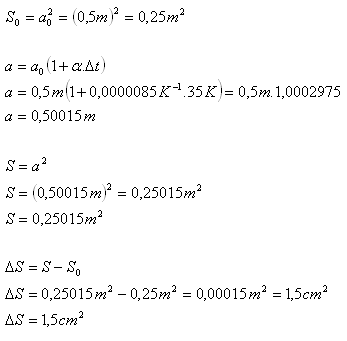
The area of the tile increases by 1,5 cm2.
8.A brass sphere (α = 1,8.10-1K-1) has a radius r1 = 2 cm at 150C. By how many 0C must it be heated so that it will no longer pass through a circular opening with radius r2 = 2,02 cm?
Solution:
Analysis:
α = 1,8.10-1K-1, r1 = 2 cm, r2 = 2,02 cm,
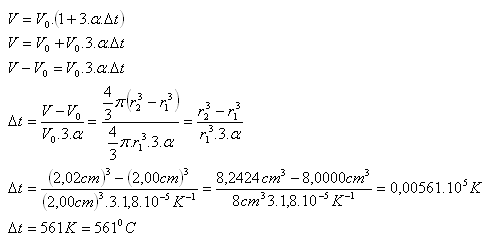
The brass sphere must be heated by 5610C to 5760C.
9.A tank wagon is filled with diesel up to the opening. (ρ = 940 kg.m-3, β = 1.10-3K-1) At 00C the wagon holds 50 tons of diesel. How much diesel will spill out through the opening if the temperature of the diesel rises to 200C during the trip?
Solution:
Analysis:
ρ0 = 940 kg.m-3, β = 1.10-3K-1, m0 = 50 000 kg, Δt = 200C = 20 K
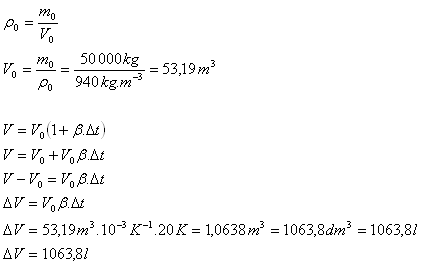
1 063,8 liters of diesel will spill out of the wagon.
10. The air in a vessel with a movable piston has a volume of 1 liter at 100C. What is the volume of the air at 400C? Also calculate the relative change in the volume of the air!
Solution:
Analysis:
V0 = 1 l = 1 dm3 = 1000 cm3, Δt = 300C = 30 K,
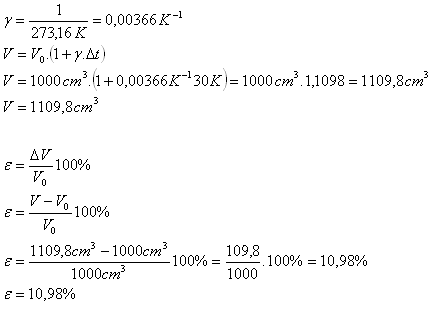
- The volume of air at 400C is V = 1109,8 cm3.
- The relative change in the volume of air is ε = 10,98%.
11.A student named “Mistaken” claimed that from the relation l = l0(1 + αΔt) it follows that with sufficiently large cooling the length “l” of a rod will be zero. Could he be right? Which important law of nature does this claim contradict?
Solution:
The length of the rod is zero if:
For example, for copper (α=1.7×10−5 K−1) it would be:
A copper rod would have to be cooled by 58 824 K. Such a low temperature does not exist in the universe. The lowest possible temperature (not yet achieved) is 0 K = -273,150C — Absolute zero.